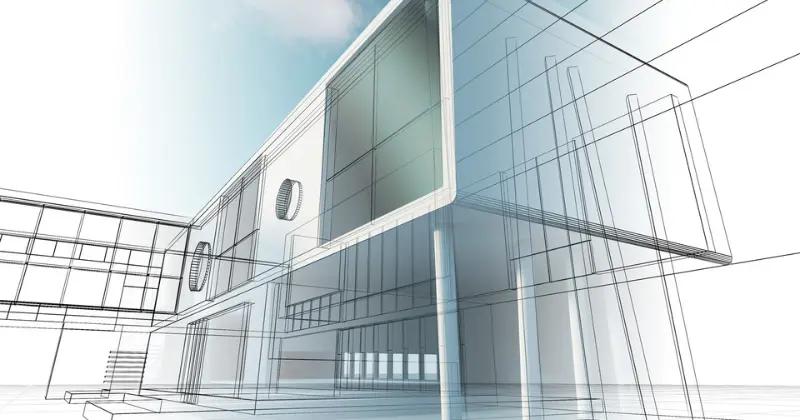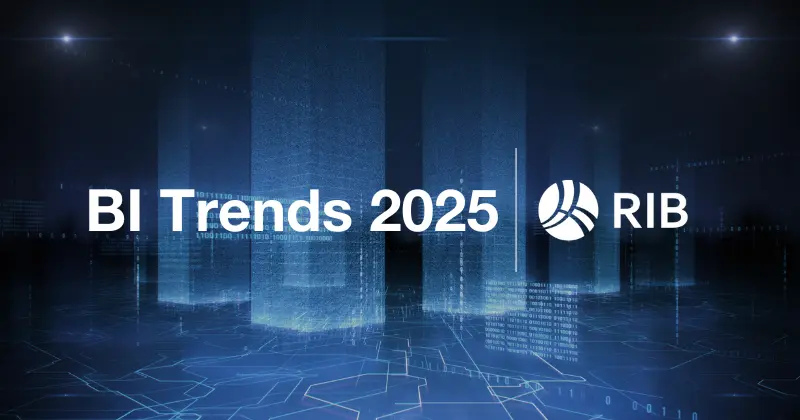11 mins read
Exploring the Top 10 Benefits of BIM in Construction

BIM, or Building Information Modeling, is the density of data represented within a digital 3-dimensional building model, compared to the traditional two-dimensional drawing, using computer modeling and a shared cloud platform. Due to the amount of data within these models, BIM also defines the project’s timeline, costs, and sustainability, which is why many refer to it as 6D BIM. It is used in global construction projects’ planning, designing, construction, and operational phases. BIM adoption has greatly benefited the AEC Industry, as there is a higher return on investments while project life cycles shorten.
BIM is now extensively used by architects, engineers, contractors, developers, owners, and most construction roles to visualize and represent different elements such as geometry, spatial relationships, material quantities, schedules, geotechnical factors, and more within the project. Implementing BIM helps save considerable cost and time, drastically improving the client-stakeholder relationship.
With continuous new developments planned and the socio-political goals of local governments, such as managing the growing population, reducing carbon emissions, and increasing foreign investment (to name a few), BIM adoption is set to increase considerably. BIM’s ability to cater to these challenges makes it a crucial tool for the future of construction.
In this blog post, we’ll explore some of the key benefits of using BIM in construction as well as common challenges companies face during adoption. Let’s get started!
Top 10 Benefits of BIM
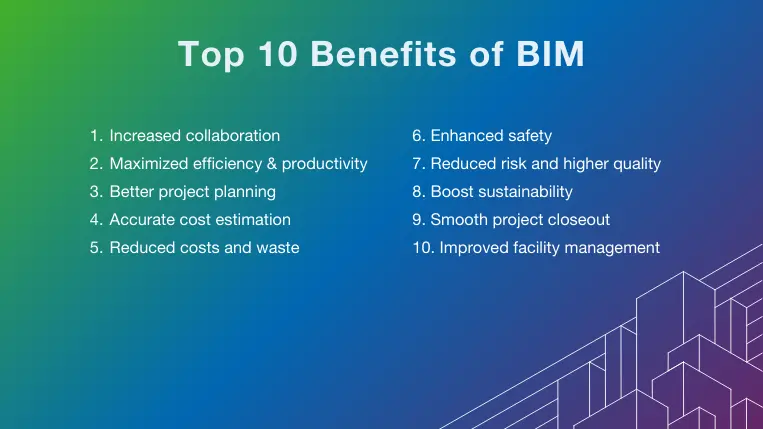
With unique functionalities and features, BIM brings a lot of value to its users. Some of the top benefits of BIM for owners, contractors, and all stakeholders across their projects and businesses are:
1. Increased collaboration: BIM simplifies the representation of construction elements, making them easily understandable for all stakeholders. As information becomes a single source of truth, it enables everyone to identify issues, risks, and improvement opportunities, fostering a culture of collaboration in construction projects.
2. Maximized efficiency and productivity: The detailed information processed within BIM allows users to deliver large-scale projects more efficiently. This enables all stakeholders to collaborate by sharing complex information in real-time, ensuring everyone is on the same page, reducing delays and errors, and boosting productivity in construction projects.
3. Better planning: Enhanced planning is another of the many ways BIM helps construction. The level of integration and visibility into all aspects of the project ensures all processes, people, and activities can be planned and organized accordingly. This allows them to avoid unwarranted and unnecessary issues that may arise affecting budgets, supply chains, and time constraints and can accordingly build contingency plans.
4. Accurate cost estimation: The sheer amount of data measured, stored, analyzed, and shared within BIM models allows stakeholders to get a 360-degree view of the project. 5D BIM technology adds a cost dimension to the 3D model, allowing companies to easily quantify resources and drive precise cost estimations for budgeting and cost control.
5. Reduced costs and waste: Reworks and construction delays account for construction wastage and cost overruns, which are incurred globally across projects. BIM estimating software mixes time and money into a single view, allowing project managers to monitor budgets, supply chains, and time constraints effectively to avoid waste and reduce costly rework.
6. Enhanced safety: Occupational Health and Safety is critical within construction projects and one of the biggest BIM benefits for contractors and subcontractors. Implementing this technology across projects helps account for all the high-risk activities and accordingly allows managers to have contingency, safe practices, and checks to prevent construction site accidents from happening.
7. Reduced risk and higher quality: With enhanced safety checks, the project manager can identify all site risks and hazards. BIM managers, project managers, and other stakeholders can review construction designs and factor in clash detection, tensile strength, load distribution, carbon emissions, etc., which can cater to alternative solutions and provide a smooth project execution with decreased errors. Studies show that 41% of companies in the AEC industry cite a reduction in errors as one of the top building information modeling advantages.
8. Boosts sustainability: Sustainability has lately become a focus of construction projects thanks to the global Net Zero agenda. In addition to the reduced waste and rework, BIM’s capability to process data across different parameters allows stakeholders to account for carbon calculations, too. This gives project engineers and managers a holistic view of emissions and allows them to alternate with lower carbon-emitting options or green designs.
9. Smooth project closeout: The success of the project is primarily defined by the smooth handover to the client. In addition to time and budget, easily digestible technical data that clients can retrieve when needed is also essential. Compared to paper-based documents and files, BIM allows clients to view component specifications, installation dates, maintenance timelines, energy performance, and any other aspect of the project, allowing for proactive closeout that meets all the quality requirements.
10. Improved facility management: Last on our list of building information modeling benefits is effective facility management. The detailed models created within BIM become quite handy after the building is completed. With as-builts incorporated within the 3D models, contractors can quickly check on maintenance, asset management, space management, and improvement. Thus, making BIM designs relevant throughout the building’s lifetime.
Common Challenges of BIM Adoption
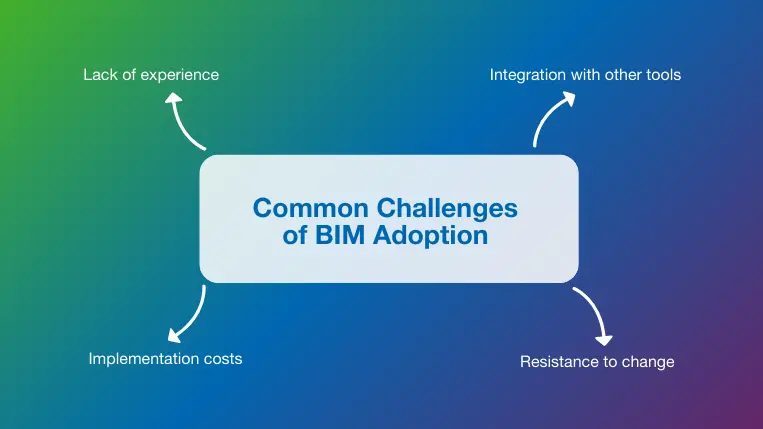
Though the BIM benefits we just mentioned can be quantified and measured across every stage of a project, many stakeholders struggle to successfully adopt the technology. This is due to the challenges they face while adopting new processes within the application of construction. Some of the most common BIM challenges are:
- Lack of experience: Though the concept is entirely plausible, many contractors need staff trained in BIM processes to implement it across their projects. Without the proper skill set, they cannot realize the full potential of BIM or, worse, make mistakes within the project, which can be costly or time-consuming to rectify. Software solution providers such as RIB Software can assist with training by providing product demos, functionality webinars, case studies, and one-on-one local customer support so that companies can quickly adopt BIM within their projects to gain the best efficiency. If it is not done well, they may be given the perception that technology is challenging to adopt.
- Integration with other tools: Technical specification has been the highest concern when adopting BIM. Efficient integration is achieved when it becomes a single source of truth, which means that it can easily interpret data by integrating with various software applications such as CAD, project management and analysis tools, and possible legacy systems. Additionally, bigger projects would involve multiple contractors using different software and tools to define the project’s data, making it problematic. This can be resolved with solutions that can work with multiple file types and can be used across the different construction phases. RIB’s solutions make it easy to read most of the file types used in the industry and process different CAD drawings and legacy documents within its systems, making this very convenient.
- Resistance to change: The construction industry is known for its resistance to change. Mostly due to the workforce being on the older side and preferring to stay with traditional practices. For example, architects and designers may disregard BIM for creative freedom. Many contractors are inclined to adopt BIM when and if mandated globally and regionally. RIB Software links with regional industry bodies to define and educate industry stakeholders on the regional and global standards defined within the construction industry and how BIM adoption could meet those standards and provide a competitive edge & efficiency across their projects.
- Implementation costs: Implementing BIM requires a significant investment in terms of software, hardware, and training. With audit checks and budget constraints, thanks to post-recession and volatile supply chains, contractors aim to turn a profit after each project. Though there are many price-competitive BIM licenses that contractors can purchase, it becomes more critical to consider when specific hardware, such as laptops, handhelds, servers, security add-ons, etc., is also required to be upgraded so that the software can be utilized. Additionally, contractors will have to consider the expenses for separate training modules for their team and the downtime this would lead to before it can be applied across their projects to make money. Lastly, as with any other software license, they could also look at separate costs for upgrades, support, and maintenance. This makes it difficult for small and medium-sized companies to adopt the technology. Though RIB’s solutions are accessible across all current generation technology, we also try to provide the best value to our customers by understanding their requirements and accordingly working around the avenues of purchase, maintenance & timeline.
Final Thoughts
Comparing the challenges to the benefits of BIM, we see that though stakeholders may face expenses while adopting the technology, the returns are realized quite quickly across their business. The time & efficiency gained in the process allows them to reduce costs, bring in new business, work on groundbreaking or complex projects, and improve their reputation within the existing or new markets, all with cooperation at the forefront.
BIM management software offers flexibility to cater to different regional market practices and processes, incorporating emerging technologies such as artificial intelligence and improving security protocols for safe & robust cloud computing, etc. These improvements, along with standards defined by industry and governments, will drive the market to adopt BIM much more quickly than before, making it quite crucial for industry stakeholders to accept it to maintain their competitive edge.
At RIB Software, we offer different solutions across the project stages that incorporate BIM, such as RIB CostX 5D BIM Software, making them unique and profitable for any stakeholder. This, coupled with our dedication to driving innovation and customer support, makes our solutions the perfect tools to boost the efficiency of modern construction companies. If you are ready to experience the power of BIM management software, get your free demo of RIB’s toolkit today!

Most Recent
11 mins read
10 mins read
10 mins read
29 mins read
Blog Categories
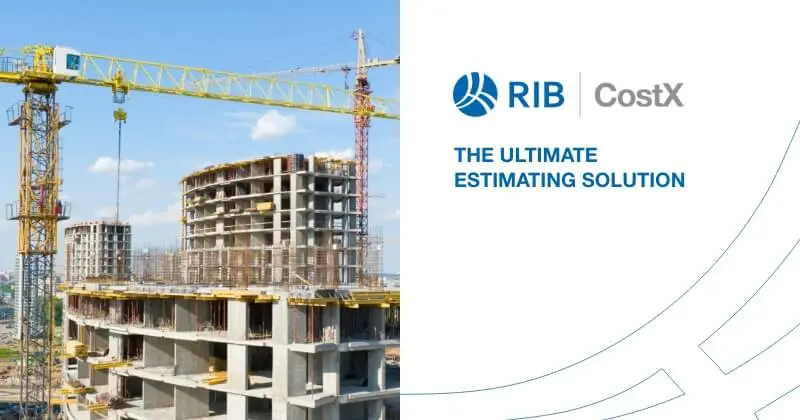
Ebook




